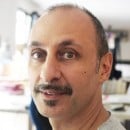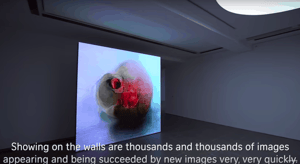With the collaboration of the neuroscientist Yukiyasu Kamitani of the University of Kyoto, the French artist Pierre Huyghe asked several people to undergo an MRI while they were being shown a certain sequence of images, or while they were thinking insistently of a given topic.
And the purpose of this investigation? To build representations of human thought using a kind of artificial intelligence software (a “deep neural network”) capable of “reading” and visually decoding our brain waves.
Huyghe then gathered the images produced using this particular research method and displayed them on large LED screens in an exhibition that will soon be closing in London, at the Serpentine Gallery.
What Huyghe has done is, to all intents and purposes, a great scientific experiment and, at the same time, an extraordinary and unprecedented artistic performance.
The result achieved is disorienting, because it is in a constant state of being reconstructed: the rhythms and breaks in the succession of images are continuously modified by the conditions in the gallery, constantly monitored by special sensors. Even the presence of visitors can influence what has become visible after they have left.
In particular, in addition to the use of Artificial Intelligence, an unexpected spectator plays a leading role in the exhibition: a group of flies that move within the gallery.
Flies and visitors can be either more or less attracted by different kinds of light, as well as by sounds (originating from the recordings of the brain waves) and smells (either human, animal or machine) that radiate from the screens. All of this leads to the creation of an unprecedented and interconnected system, where the boundaries between humans, animals and the artificial – and between art, rationality and the subconscious – are so blurred that they disappear.
“What is made is not necessarily due to the artist as the only operator: the only one generating intentions instead is an ensemble of intelligences, of biotic or abiotic entities, beyond human reach. The situation that is created has no duration, is not addressed to anyone”, explained the artist in a public conversation with the art critic Hans Ulrich Obrist, director of the Serpentine Gallery.
The co-existence of us humans alongside other ‘entities’ like insects and artificial intelligence, reminds us that the way we interpret the world is specific and ‘right’ only for us.
To say it in the words of the artist:
“You frame a rule, set the conditions, but you cannot define how a given entity will interact with another. … What I show is a set of elements and the way they collide, confront and agree with each other….I do not want to exhibit something to someone, I want to do the reverse: I want to exhibit someone to something.”

